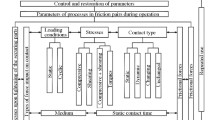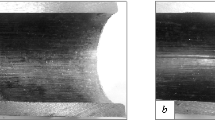Abstract
It was determined experimentally that to provide complete sealing, the value of the contact pressure on the sealing surface must be three times greater than the internal pressure. The tightness of flange connections is provided by creating the necessary pressure on the sealing surfaces of the flanges. Moreover, the required specific pressure is created in the seals by tightening the bolts fastening the flanges. The amount of leakage is influenced by the surface roughness and the accuracy of the manufacturing of the sealing elements.
Similar content being viewed by others
Avoid common mistakes on your manuscript.
The sealing element of high-pressure flange connections of oil equipment is a gasket, which is made of steel. The gasket sits on a groove located on the end of the flange in the form of a ring and creates a tightness under high pressure.
MATERIALS AND METHODS
As is known, flange connections are strong-tight detachable connections of fittings vessels, connecting parts of pipelines, etc. Despite the standardization of flanges, the final choice of flanges and the calculation of their individual elements are up to the designer. The design of flanges, especially flanges that are not provided for by standards, usually comes down to assigning their strength dimensions without detailed calculation, largely based on the theory of similarity. However, an important peculiarity of all flange connections is to provide not only a strong connection, but also a tight, i.e., hermetic, one.
RESULTS AND DISCUSSION
The tightness of flange connections is provided by creating the necessary pressure on the sealing surfaces of the flanges. Moreover, the required specific pressure is created in the seals by tightening the bolts fastening the flanges. The amount of leakage is influenced by the surface roughness and the accuracy of the manufacturing of the sealing elements. However, an increase in manufacturing accuracy and a decrease in the roughness of machining leads to an increase in the cost of production. Therefore, to provide tightness, the seal must be mechanically deformed to ensure that it adheres to the sealing surfaces, filling all surface irregularities and defects.
A high-pressure flange seal (Fig. 1) consists of a metal ring (gasket), which, under the action of internal pressure, is pressed against the wall of the ring groove, providing tightness. Such flange connections are widely used in oilfield equipment.
In the absence of internal pressure, the axial force that occurs when the bolts are tightened in ordinary flange connections is taken by the gasket. At the same time, with an increase in the width of the gasket, the possibility of crushing its contact surface is excluded; i.e., the greater the width of the gasket, the greater the second component of the force acting on the bolt. Thus, increasing the width of the spacer leads to the need to increase the size of the bolts, which in turn will increase the width of the spacer, etc. Then, at high pressures, it is necessary to use wide gaskets, bolts with large diameters, and massive flanges, which ultimately reduces the efficiency of the design [1, 5].
During operation, the bolts of flange connections are impacted by the sum of two forces: (1) the hydrostatic force calculated from the outer diameter of the gasket and acting on the flange plate and (2) the axial component of the force, which occurs under the action of the contact pressure providing the tightness of the connection, on the interface between the gasket and the flange.
Therefore, metal octagonal gaskets are used in high-pressure flange connections, the sealing force of which is approximately 6–8% of the bolt torque. Moreover, the dimensions of the gasket in these cases will not depend on the tightening force of the bolts [2, 3, 6].
To provide tightness in flanged joints with a metal gasket, the movement of the gasket working surface reduced to the axis of the flange must be equal to the sum of the deformation of the bolt and the flange from bending and turning. In this case, the compatibility condition is satisfied and there will always be pressure on the contact surface. For this pressure to be equal to 3P0, the gasket must return to its original position. The thickness of the flange is chosen in such a way that in this case the internal pressure has a maximum value. The tightness condition was mathematically expressed by the following dependence:
where \({{\Delta }_{\delta }}\) is the axial deformation of the bolt only due to the internal pressure, \({{\Delta }_{\delta }} = \frac{{{{P}_{0}}d_{{02}}^{2}{{l}_{c}}}}{{2{{E}_{\delta }}z{{d}^{2}}}}\); \({{l}_{c}}\) is the effective bolt length, \({{l}_{c}} = 2h + 2{{h}_{H}} + d\); axial displacement from internal pressure of the flange section where the groove is located; Δ' is the tightness.
Let us consider a simplified flange connection diagram. We replace the shell with a cylinder, the thickness of which \({{\delta }_{{{\text{avg}}}}} = 0.5\left( {{{\delta }_{0}} + {{\delta }_{1}}} \right)\), and the average radius \({{r}_{{{\text{avg}}}}} = 0.5\left( {{{\delta }_{{{\text{avg}}}}} + {{d}_{0}}} \right)\). The flange is considered as a rigid ring in the radial and axial direction. In this case, the resulting bending moment at the junction of the flange with the shell can be determined from the condition of equality of the angles of rotation. The angle of rotation of the cylinder from the moment М1 of the internal pressure Р0 is calculated by the formula
Flange rotation angle (ring)
where \(l = 0.5{{D}_{{{\text{avg}}}}} - {{r}_{{{\text{avg}}}}}\).
Equating (1) to (2) and solving the resulting equation with respect to М1, we obtain
Numerical analysis shows that for real structures it is possible to accept \(k = \left( {0.5{\kern 1pt} - {\kern 1pt} 1.5} \right)\). Taking into account the bending deformation of the flange, \(k = \left( {0.6{\kern 1pt} - {\kern 1pt} 1.8} \right)\).
To establish the reliability of the found parameters, the tightness condition \({{\Delta }_{\delta }} + {{\Delta }_{\Phi }} \leqslant \Delta - \Delta {\kern 1pt} '\) [4] is checked.
CONCLUSIONS
It is noted that, to provide complete sealing, the value of the contact pressure on the sealing surface must be three times greater than the internal pressure.
REFERENCES
Ragimova, M., Issues of density and tightness of flange connections, Avtom., Telemekhanizatsiya Svyaz’ Neftyanoi Prom-sti, 2020, no. 11, pp. 43–46. https://doi.org/10.33285/0132-2222-2020-11(568)-43-46
Mordvinov, A.A., Zakharov, A.A., Miklina, O.A., and Poluboyartsev, E.L., Ust’evoe oborudovanie fontannykh i nagnetatel’nykh skvazhin: Metodicheskie ukazaniya (Wellhead Equipment of Flowing and Pumping Wells), Ukhta: Ukhtinskii Gos. Tekh. Univ., 2004.
Golubev, A.I. and Kondakov, L.A., Uplotneniya i uplotnitel’naya tekhnika. Spravochnik (Sealing and Sealing Equipment: Reference Book), Kondakov, L.A., Ed., Moscow: Mashinostroenie, 1994.
Duffin, R.J., Peterson, E., and Zener, C., Geometric Programming, New York: John Wiley & Sons, 1967.
Khazov, B.F. and Didusev, B.A., Spravochnik po raschetu nadezhnosti mashin na stadii proektirovaniya (Reference Book on Analysis of Reliability of Machines at the Design Stage), Moscow: Mashinostroenie, 1986.
Reklaitis, G.V., Ravindran, A., and Ragsdell, K.M., Engineering Optimization: Methods and Applications, New York: John Wiley & Sons, 1983.
Author information
Authors and Affiliations
Corresponding author
Ethics declarations
The authors declare that they have no conflicts of interests.
Additional information
Translated by K. Gumerov
About this article
Cite this article
Ragimova, M.S. Development of Methods for Optimization and Machine Design of the Connecting Unit of Oil-Field Equipment. J. Mach. Manuf. Reliab. 52, 351–353 (2023). https://doi.org/10.3103/S105261882304012X
Received:
Revised:
Accepted:
Published:
Issue Date:
DOI: https://doi.org/10.3103/S105261882304012X





